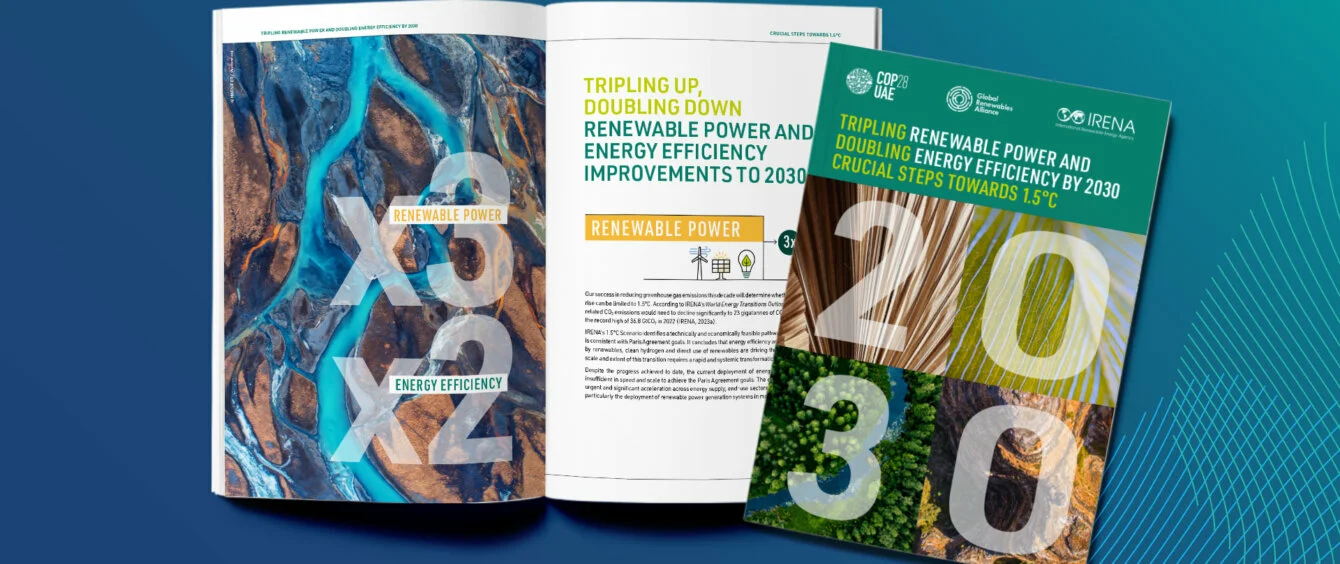In the last decade, renewable energy capacity worldwide has more than doubled from 1,566 GW to an extraordinary 3,372 GW, according to International Renewable Energy Agency (IRENA) data.
However, in the space of the next seven years, it must triple again, to 11,174 GW. Not only this, but energy efficiency improvements must double.
This is necessary to limit the rise in global temperatures to 1.5°C above pre-industrial levels, according to a report published under the auspices of IRENA, the Global Renewables Alliance and the presidency of the COP28 conference on climate change.
Next seven years are critical
The report says the current decade is critical for the success of the energy transition. Despite huge progress in the renewable energy sphere, the world remains off-track on climate targets. In 2022, greenhouse gas emissions hit record levels.
IRENA estimates that if all current pledges and plans made by governments were fully implemented, it would reduce carbon dioxide emissions by just 6% by 2030 below 2019 levels. What is needed, it says, is a 50% cut.
Yet the tools to improve are readily available. In the vanguard of the energy transition are mature, commercially-viable technologies, namely wind and solar power.
In fact, renewables now represent the least-cost pathway for power generation from any source, the report says.
While other renewable energy technologies also need to expand, wind and solar are expected to dominate new capacity additions. Under IRENA’s 1.5°C scenario, variable renewable energy makes up 46% of electricity generation by 2030, up from 10% in 2021. This is supported by the expansion of other renewable energy technologies such as hydro, biomass, marine and geothermal power.
Installed solar capacity rises 1,062 GW in 2022 to more than 5,400 GW, while wind expands from 899 GW to over 3,500 GW, of which about 500 GW would be offshore.
The increase in wind and solar needs to be backed by a huge expansion in battery storage capacity, which increases by a factor of 21 by 2030 to 359 GW, compared with 17 GW in 2020.
However, the installation rate in 2022 for new renewable power capacity was less than one third of the 1,000 GW required annually to 2030.
Energy efficiency is a key component of the transition
The energy efficiency goal will be met not just by the use of more efficient electric motors, improved building insulation and heat pumps, but by significant behavioural changes. These include a shift from private cars to collective transport and from passenger aviation and road-based freight to rail.
Energy efficiency improvement will above all be underpinned by much greater electrification of the wider economy. Doubling the rate of energy efficiency improvement is essential for curbing the growth of global energy consumption without compromising the provision of energy services, according to the report.
Key recommendations for policy holders
The big question, however, is how to bridge the gap between current installation rates and efficiency improvements, and the much higher rates required.
- First, the report focuses on redesigning and expanding electricity grid systems to optimise their use with a much higher percentage of variable renewable power generation. This includes a wide range of advances from more interconnectors to changes in grid operation and market design.
- Second is the need for policy and regulation that stimulates and facilitates the twin objectives of renewable energy growth and more rapid improvements in energy efficiency.
- Third is much increased international collaboration. This is, in particular, to speed up the energy transition in emerging and developing economies, where energy transition spending remains far below the levels of the advanced economies.
- Closely linked is the fourth priority, the need to mobilise more capital in pursuit of energy transition goals, especially in the developing world.
- And, finally, all this will require a skilled workforce, providing opportunities for re-skilling and empowering women and under-represented groups.
Although challenging, IRENA believes that what it has set out is achievable, and that the energy transition pathway will unlock major economic, environmental and social benefits. However, it requires urgent action on the part of all stakeholders, which, when it comes to climate change, means everyone — from governments, companies down to the individual.
